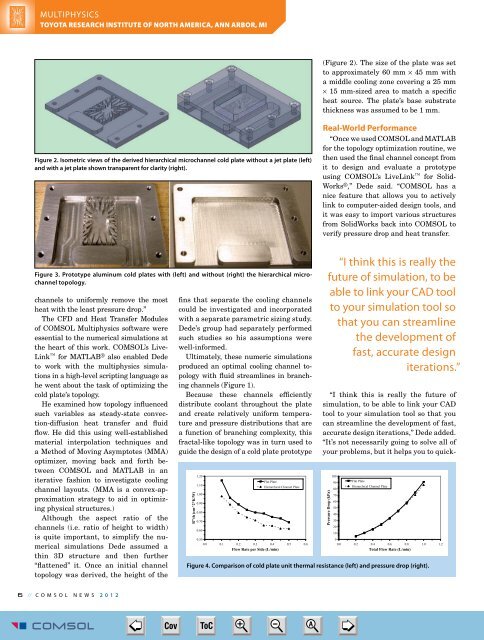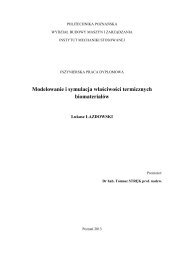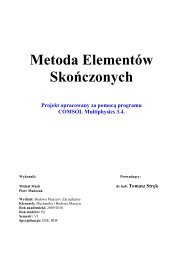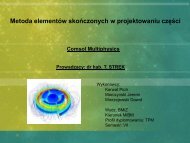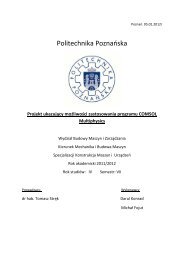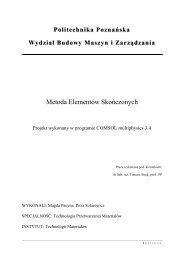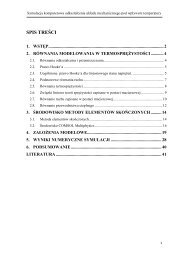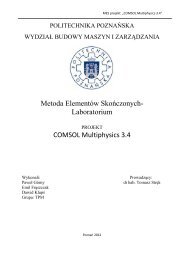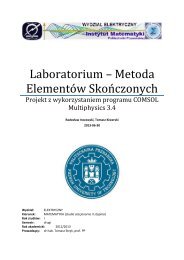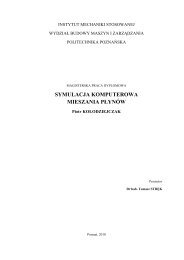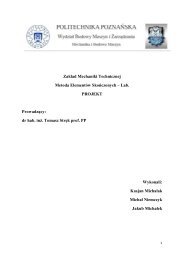COMSOL News
COMSOL News
COMSOL News
Create successful ePaper yourself
Turn your PDF publications into a flip-book with our unique Google optimized e-Paper software.
MULTIPHYSICS<br />
TOYOTA RESEARCH INSTITUTE OF NORTH AMERICA, ANN ARBOR, MI<br />
(Figure 2). The size of the plate was set<br />
to approximately 60 mm × 45 mm with<br />
a middle cooling zone covering a 25 mm<br />
× 15 mm-sized area to match a specific<br />
heat source. The plate’s base substrate<br />
thickness was assumed to be 1 mm.<br />
Figure 2. Isometric views of the derived hierarchical microchannel cold plate without a jet plate (left)<br />
and with a jet plate shown transparent for clarity (right).<br />
Real-World Performance<br />
“Once we used <strong>COMSOL</strong> and MATLAB<br />
for the topology optimization routine, we<br />
then used the final channel concept from<br />
it to design and evaluate a prototype<br />
using <strong>COMSOL</strong>’s LiveLink for Solid-<br />
Works ® ,” Dede said. “<strong>COMSOL</strong> has a<br />
nice feature that allows you to actively<br />
link to computer-aided design tools, and<br />
it was easy to import various structures<br />
from SolidWorks back into <strong>COMSOL</strong> to<br />
verify pressure drop and heat transfer.<br />
Figure 3. Prototype aluminum cold plates with (left) and without (right) the hierarchical microchannel<br />
topology.<br />
channels to uniformly remove the most<br />
heat with the least pressure drop.”<br />
The CFD and Heat Transfer Modules<br />
of <strong>COMSOL</strong> Multiphysics software were<br />
essential to the numerical simulations at<br />
the heart of this work. <strong>COMSOL</strong>’s Live-<br />
Link for MATLAB ® also enabled Dede<br />
to work with the multiphysics simulations<br />
in a high-level scripting language as<br />
he went about the task of optimizing the<br />
cold plate’s topology.<br />
He examined how topology influenced<br />
such variables as steady-state convection-diffusion<br />
heat transfer and fluid<br />
flow. He did this using well-established<br />
material interpolation techniques and<br />
a Method of Moving Asymptotes (MMA)<br />
optimizer, moving back and forth between<br />
<strong>COMSOL</strong> and MATLAB in an<br />
iterative fashion to investigate cooling<br />
channel layouts. (MMA is a convex-approximation<br />
strategy to aid in optimizing<br />
physical structures.)<br />
Although the aspect ratio of the<br />
channels (i.e. ratio of height to width)<br />
is quite important, to simplify the numerical<br />
simulations Dede assumed a<br />
thin 3D structure and then further<br />
“flattened” it. Once an initial channel<br />
topology was derived, the height of the<br />
fins that separate the cooling channels<br />
could be investigated and incorporated<br />
with a separate parametric sizing study.<br />
Dede’s group had separately performed<br />
such studies so his assumptions were<br />
well-informed.<br />
Ultimately, these numeric simulations<br />
produced an optimal cooling channel topology<br />
with fluid streamlines in branching<br />
channels (Figure 1).<br />
Because these channels efficiently<br />
distribute coolant throughout the plate<br />
and create relatively uniform temperature<br />
and pressure distributions that are<br />
a function of branching complexity, this<br />
fractal-like topology was in turn used to<br />
guide the design of a cold plate prototype<br />
R''th (cm^2*K/W)<br />
1.20<br />
1.10<br />
1.00<br />
0.90<br />
0.80<br />
0.70<br />
0.60<br />
0.50<br />
Flat Plate<br />
Hierarchical Channel Plate<br />
0.0 0.1 0.2 0.3 0.4 0.5 0.6<br />
Flow Rate per Side (L/min)<br />
“I think this is really the<br />
future of simulation, to be<br />
able to link your CAD tool<br />
to your simulation tool so<br />
that you can streamline<br />
the development of<br />
fast, accurate design<br />
iterations.”<br />
“I think this is really the future of<br />
simulation, to be able to link your CAD<br />
tool to your simulation tool so that you<br />
can streamline the development of fast,<br />
accurate design iterations,” Dede added.<br />
“It’s not necessarily going to solve all of<br />
your problems, but it helps you to quick-<br />
Figure 4. Comparison of cold plate unit thermal resistance (left) and pressure drop (right).<br />
Pressure Drop (kPa)<br />
100<br />
90<br />
80<br />
70<br />
60<br />
50<br />
40<br />
30<br />
20<br />
10<br />
0<br />
Flat Plate<br />
Hierarchical Channel Plate<br />
0.0 0.2 0.4 0.6 0.8 1.0 1.2<br />
Total Flow Rate (L/min)<br />
6 // <strong>COMSOL</strong> NEWS 2 0 1 2<br />
<strong>COMSOL</strong> <strong>News</strong> 2012-17.indd 6<br />
➮<br />
Cov ToC + – A<br />
➭<br />
5/15/12 2:59 PM


